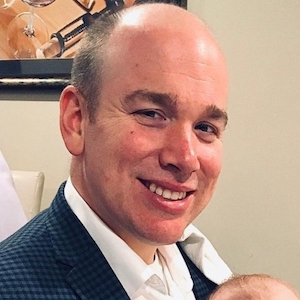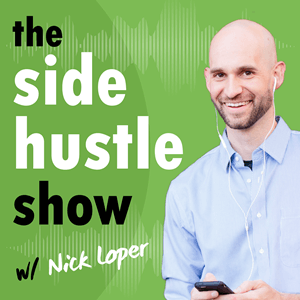
How do you go from gym whistles and dodgeballs to foam cannons and $150,000 in side hustle income?
This elementary PE teacher discovered a unique business opportunity that lets him make money over summer break — and have a lot of fun along the way.
Tim Carstensen from FoamPartyAllStars.com runs a full-service mobile foam party that brings an interactive experience to the Chicagoland area. The best part is he started with zero business experience and figured it out as he went.
Tune in to Episode 676 of the Side Hustle Show to learn:
- The smart marketing strategy that got his first customers
- How he scaled from 1 foam cannon to 9 setups across multiple locations
- Why this business model works better than bounce house rentals
Sponsors
- Mint Mobile — Cut your wireless bill to $15 a month!
- Indeed – Start hiring NOW with a $75 sponsored job credit to upgrade your job post!
- OpenPhone — Get 20% off of your first 6 months!
- Shopify — Sign up for a $1 per month trial!
How a Foam Party Business Actually Works
Tim shows up with professional-grade foam cannons that create walls of bubbles up to shoulder height. Kids dance, play, and frolic in kid-friendly foam while upbeat music plays and a professional voiceover builds excitement with countdowns.

Most birthday parties run $375 for one hour. Bigger events with multiple cannons go for more.
For Tim’s first official gig, it was a two-cannon glow foam party (special UV-reactive foam that glows in the dark) for a school with a couple hundred kids.
Not exactly easing into it, but he pulled it off and the business hasn’t slowed down since.
The Research That Started It All
Tim was originally researching bounce house rentals but discovered the insurance costs were prohibitive — around $5,000-$6,000 annually even for just one or two units.
While browsing party rental Facebook groups (yes, there’s a group for everything), he noticed companies in warmer states offering foam parties for kids alongside their bounce houses.
Tim researched his area and found only one competitor 50 miles north. That was his green light.
He found a Facebook group specifically for foam party providers nationwide and studied every single post to understand the business model, startup costs, and success stories.
Getting Those First Customers: The 700 Postcard Strategy
Tim didn’t wait to build a following and went straight to where his customers already were.
He compiled a list of every daycare, summer camp, park district, library, and elementary school within 35-40 miles and sent 700 postcards via Vistaprint.
With the message, “We bring a foam party to you,” his postcard positioned foam parties as solutions for specific events:
- Summer camps
- School events
- Church gatherings
- Library summer reading kickoffs
- Block parties
- Birthday parties
Sending postcards in January meant catching organizations during their summer planning season. This gave Tim months to prepare while collecting deposits upfront.
Startup Costs and Equipment
For his initial investment, it was about $2,500 for the professional-grade foam cannon, plus another $1,000-$1,500 for barriers, tent with branding, hoses, electrical cords, speakers, and miscellaneous tools.

The setup requirements:
- Water source (regular hose hookup works)
- Electrical outlet (regular outlet for one cannon)
- Generator for multiple cannons or remote locations
Insurance costs: Around $1,200-$1,300 annually for a $1 to $2 million policy — significantly cheaper than bounce house insurance.
Tim reinvested deposits from early bookings into additional equipment, buying his second and third setups before even doing his first party.
8 Local Marketing Strategies That Actually Work
1. Direct Mail to B2B Customers
Tim’s 700-postcard campaign to daycares, schools, and camps generated his first wave of bookings. He now sends different postcards to different types of organizations rather than one-size-fits-all messaging.
2. Facebook and Google Ads (Low Budget, High ROI)
Tim spends on Google Ads targeting “foam party near me” — virtually no competition means cheap clicks and easy visibility.
He also runs Facebook ads targeting local moms. With bright photos and short videos of kids playing in foam, his posts are high-engagement.
3. Local Facebook Groups
Tim (using his wife’s account to join facebook groups for moms) posts in every neighboring Facebook group with photos and explanations.
Since “98% of the time it’s the mom that is booking the party,” this targets the actual decision-makers.
4. Built-in Referral Marketing
Tim hired a voiceover artist to create a 25-second commercial that plays during every foam party, encouraging parents to get business cards. This generates inquiries on the spot.
5. Chain Reaction Strategy
Once Tim proved himself with one location of a daycare chain, word spread to other locations. Three locations became twelve the following year.
6. Strategic Partnerships
Some chain daycares require vendor registration through corporate offices. Breaking through that initial paperwork barrier opens doors to multiple locations.
7. Google Business Profile Optimization
Tim shows up on the first page for “foam party Chicago” despite being in the suburbs, driving inquiries from the city.
8. Email Follow-up for Reviews
Tim sends thank-you emails after each party with direct links for five-star reviews and personal contact info for any concerns — preventing negative reviews while encouraging positive ones.
Scaling Beyond Solo Operation
Tim ran nearly 100 parties himself in the first season.
Now, he manages a team of summer-only staff: other teachers (who have summers off) and college students. He reserves his time for larger events or last-minute rescues if someone calls in sick.
- Foam Party All Stars now has 9 full setups
- Most events can run with just one cannon and one staffer
- Scheduling is manual: Tim prefers not to show open dates online (so people assume they’re in demand)
“If we had a full calendar of when we’re available, [people will be] like, ‘Wow, these people are always available. They must not be too much in demand.’”
What Clients Are Really Buying
Sure, it looks like bubbles and music, but clients are buying relief, peace of mind, and time back in their day.
Tim positions foam parties as a support system that takes event planning stress off busy parents and administrators.
The experience factor: If you’ve never seen a foam party in action, it’s hard to picture just how fun it really is. Pictures don’t capture the pure joy of kids playing in shoulder-deep foam.
What About Weather?
Foam parties are surprisingly weather-tolerant.
Tim can do parties in light rain (kids are getting wet anyway), but lightning means automatic postponement.
Tim uses a lightning tracker app and calls it off if there’s a safety risk. But in most cases, clients choose to push through rain rather than reschedule due to invitation logistics.
Tools and Tech
Equipment:
- Professional foam cannons with special glow additives for night events
- Lightning detection apps for safety monitoring
- PVC and vinyl barriers with branded marketing
- Vistaprint (for postcards and marketing materials)
Business Operations:
- Manual scheduling system
- Email and phone-based inquiry system with 24-hour response promise
- Backup equipment for every party
Revenue Streams and Expansion Ideas
Core Services:
- Birthday parties: $375 for one hour
- Large events: Multi-cannon setups for hundreds of participants
Premium Add-ons:
- Glow foam for evening events
- Multiple cannons for larger crowds
- Extended service areas for premium fees
Potential Expansions:
- Gender reveal parties (colored foam)
- Community festivals and fun runs
- Corporate team building events
Common Mistakes to Avoid
1. Taking the Wrong Clients at Wrong Prices
Tim learned to set boundaries early and charge appropriately rather than discounting to land initial work.
2. Not Vetting Team Members Properly
“Hire slow, fire fast” became Tim’s mantra after learning that poor performers can damage brand reputation quickly.
3. Over-Promising on Event Duration
Tim actually talks clients out of two-hour parties, explaining that one hour is optimal for kids’ attention spans and reduces mud risk.
4. Inadequate Backup Planning
Always bring backup equipment. Tim learned this when foam cannons failed during countdown moments with chanting kids.
Day-in-the-Life: Summer Operations
During peak season, Tim wears all the hats behind the scenes while trying to keep the foam out of his inbox.
He handles:
- Booking and client communication
- Scheduling and logistics
- Training team members to run parties solo
- Emergency rescheduling due to weather
Why the Seasonality Works
Because the business is so concentrated into four months, Tim gets to keep his full-time teaching job the rest of the year.
It’s the kind of seasonal hustle that fits naturally into an educator’s schedule.
Work-Life Balance
Tim now focuses on managing the business and only steps in for large or high-stakes events. That shift has allowed him to prioritize being present for his kids.
What’s Next for Tim?
For now, Tim’s keeping both feet in two worlds by teaching during the school year and being a foam-slinging entrepreneur in the summer.
His goal is to step back from the day-to-day without slowing down the business. He’s focused on training his team, dialing in systems, and saying yes only to the biggest, most high-impact events.
While some foam party businesses around the country are starting to explore franchising, Tim’s focused on depth over expansion.
For him, it’s not about building a national brand but building a business that fits his life.
Tim’s #1 Tip for Side Hustle Nation
“If you see an opportunity, go do it.”
Episode Links
- Foam Party All Stars
- Vistaprint
- Next Insurance
- The 23 Best Side Hustles for Teachers: Earn $1000 a Week or More
- 35 Ways to Make Money in College: Up to $10k Per Year Part-Time
- Facebook Groups: Grow and Monetize a Community Around Something You Care About
- The 21 Best Summer Side Hustles: Earn $1000 a Month or More!
- How to Start a Bounce House Rental Business (Investing in “Inflatable” Real Estate)
Serious About Making More Money?
- Start Your Free $500 Challenge. My free 5-day email course shows you how to add $500 to your bottom line.
- Join the free Side Hustle Nation Community. The free Facebook group is the best place to connect with other side hustlers and get your questions answered.
- Download The Side Hustle Show. My free podcast shares how to make extra money with actionable weekly episodes.








No responses yet